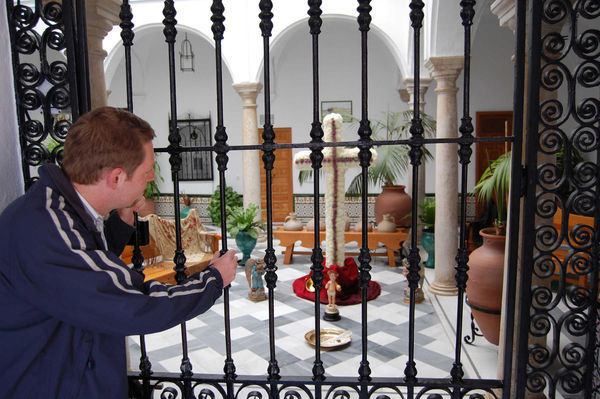Strolling Córdoba’s Back Streets
By Rick StevesWandering the Art Deco streets of Córdoba, I'm drawn to a commotion on a square. It's almost midnight — everyone's out, savoring a cool evening. Short men with raspy tobacco voices and big bellies — called curvos felicidad (happiness curves) — jostle and bark as a dozen little school girls rattle a makeshift stage, working on their interpretation of "sultry." The scene takes me back to my earliest visits to southern Spain, when the region was far more rustic, even exotic-feeling, to my American eyes. But tonight it's clear that even in a newer world of smartphones and straightened teeth, Andalucía's flamenco culture still thrives.
While Córdoba is among Andalucía's top three cities for sightseeing (with Granada and Sevilla), most visitors come just to see its famed Mezquita — a vast mosque with a cathedral built in its middle and one of the glories of Moorish Spain. The Mezquita is surrounded by a touristy zone of shops and tour-group-friendly restaurants, but beyond that, the city has almost no crowds. And late at night there are fewer tourists yet.
And, as anywhere, just wandering the back streets gets you all alone with the town. Exploring the residential back lanes of old Córdoba you can catch an evocative whiff of the old town before the recent affluence hit. As you explore, be a keen observer.
Streets are narrow — designed to provide much appreciated shade. To keep things even cooler, walls are whitewashed and thick — providing a kind of natural air-conditioning. To counter the boring whitewash, doors and windows are colorful. Iron grills cover the windows. Historically these were more artistic, now more practical — a reminder of the persistent gap through the ages between rich and poor. Stone bumpers on corners protected buildings against reckless drivers. As you'll see, scavenged secondhand ancient Roman pillars worked well. Lanes are made of river-stone cobbles: cheap and local. They provided drains down the middle of a lane while flanked by smooth stones, which stayed dry for walking. Remnants of old towers from minarets survive, built into today's structures. Muslim Córdoba peaked in the 10th century with an estimated 400,000 people…and lots of now-mostly-gone neighborhood mosques.
In Córdoba, patios are taken very seriously. That's especially clear each May when a fiercely competitive contest is held to pick the city's most picturesque. Patios, a common feature of houses throughout Andalucía, have a long history here. The Romans used them to cool off, and the Moors added lush, decorative touches. The patio functioned as a quiet outdoor living room, an oasis from the heat. Inside elaborate ironwork gates, roses, geraniums, and jasmine spill down whitewashed walls, while fountains play and caged birds sing. Some patios are owned by individuals, some are communal courtyards for several homes, and some grace public buildings like museums or convents.
Today, homeowners take pride in these mini-paradises, and have no problem sharing them with tourists. Keep an eye out for square metal signs that indicate historic homes. As you stroll Córdoba's back streets, pop your head into any wooden door that's open. The owners (who keep their inner black iron gates locked) enjoy showing off their picture-perfect patios. A concentration of Córdoba's previous patio-contest award-winners runs along Calle San Basilio and Calle Martín Roa, just across from the Alcázar's gardens.
After dark, the flowers' colors fade, but the cultural colors grow brighter. Thanks largely to its siesta tradition, Spain's typical day picks up energy as the sun goes down. Admittedly, I'm not keen on napping through key sightseeing hours, but in Spain I find that an early-evening rest lets me recharge enough to enjoy the late-night fun that most tourists miss.
It's always striking how, anywhere in Spain, a restaurant recommended in all the guidebooks can feel like a tourist trap at what most non-Spaniards consider dinnertime…but by 11 p.m., the same space feels like a local secret. After virtually all the tourists have long since headed back to their hotels, locals retake their turf. Outside the restaurants and bars, Spaniards of all ages gather in squares and stroll promenades. This phenomenon seems especially stark in well-touristed — yet still deeply traditional — Andalucía.
Despite my decades of experience with late-night Spanish exuberance, it still often catches me by surprise. On one recent visit, after a morning spent marveling at Cordoba's sights, an afternoon exploring its countless back lanes, and a convivial night crawling its tapas bars, I went to bed well after midnight. As I climbed into bed, city finally seemed quiet. Just as I dozed off, a noisy and multigenerational parade rumbled down the cobbled lane that I'd thought promised a good night's sleep. Standing in my underwear and wrapped in the drapes, I peered furtively out my window. Below a band of guitars and castanets with a choir of those raspy voices funneled down my narrow alley. I watched as grandmothers — guardians of a persistent culture — made sure the children were picking up their Andalusian traditions. I felt like a Peeping Tom…until one woman looked up at me, caught my eye, and nodded, seemingly satisfied that I was witnessing the enduring richness of their heritage.


